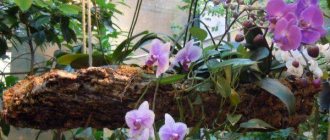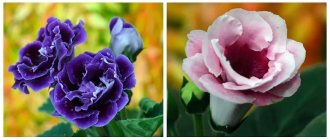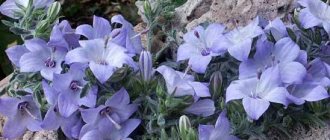Description
Campanula garden is undemanding to growing conditions and grows in a variety of places - forests, steppes, rocks and wastelands.
The flower's homeland is the Mediterranean countries; it grows well in regions with a temperate climate - in Asia, North America, and the Caucasus. The plant is herbaceous, perennial, the stem can be straight or creeping, up to 1 m long. The leaf blades on long cuttings are heart-shaped, about 7 cm long. The shape of the inflorescences is pyramidal. Flowers up to 4 cm in diameter, various shades: white, purple, blue, pink, etc.
The flowering phase begins in June and ends in September.
Campanula garden is a perennial, moisture-loving crop that requires regular watering, especially during the active growing season and flowering phase. The soil must be drained so that water does not stagnate, as the root system may rot. If you remove faded flowers from the bush in a timely manner, you can activate and stimulate the formation of new buds. In October, the stems are cut off and the root system is insulated with fallen leaves or peat.
Note to the florist
Why doesn't Campanula bloom?
Actually, it is for the sake of flowers that campanula is grown at home. The biggest disappointment for gardeners is if in the spring there are no buds on the bush or very few of them. There may be several reasons:
- Lack of nutrients. For abundant flowering, the plant needs fertilizing, it is this that gives the flower strength. During the period of active growth, fertilize the soil twice a month.
- The flowerpot is too spacious. To have a lot of flowers, the plant must be crowded.
- No trimming. Pruning is an indispensable condition for the flowering of the bell. The bush should be formed annually, leaving shoots with several buds. Buds will not appear on woody shoots.
Trimmed cuttings easily take root in water and thus new, young bell plants are obtained.
Why does campanula wither?
- Lack of light;
- Dry air;
- Incorrect watering regime (frequency and amount of moisture are adjusted depending on the time of year);
- Presence of drafts in the room;
- Damage by insects or infections.
The delicate bell requires careful treatment. Sometimes the cause of wilting of shoots, leaves and inflorescences can be an uncomfortable placement of branches. They should hang down freely, so you should not lift the shoots up.
Kinds
Campanula lactiflora
Campanula lactiflora
The plant is perennial, with a branched stem about 90 cm long, light-loving. The diameter of the flower is about 3 cm, the shade is milky or lilac, the inflorescence is pyramidal.
Carpathian Campanula (Campanula carpatica)
Carpathian Campanula (Campanula carpatica)
In nature it grows on the slopes of the Carpathians and Central European calcareous rocks. Decorative, unpretentious, long-flowering frost-resistant crop. The height of the bushes is about 40 cm, the stems are mostly erect, the shoots are covered with villi, branching. The plastic sheets are green in color, slightly hairy, with veins, rounded and heart-shaped. The flowers are large, single, cup-shaped, about 5 cm in diameter, blue, white or purple in color, formed on the tops of stems and branches.
The flowering phase begins in mid-summer and ends in autumn. Used in the design of rock gardens and balconies.
Campanula persicifolia
Campanula persicifolia
The plant is up to 95 cm high, the leaf blades are similar to peach leaves, the flowering phase lasts all summer, the flowers are blue or white.
Campanula trachelium
Campanula trachelium
The stem is branched, straight, its height is about 1 m. The flowers are large, white or light purple. Blooms profusely until late summer. Leaf blades are jagged and rough.
Pozharsky's bell (Campanula poscharskyana)
Pozharsky's bell (Campanula poscharskyana)
The leaf blades are round in shape, the shoots are creeping, long, the flowers are small, up to 2.5 cm in diameter, bright lilac in color. Cold-resistant and shade-tolerant plant.
Bluebell (Campanula glomerata)
Bluebell (Campanula glomerata)
The plant is about 60 cm high, the stem is erect, sparsely bristly. The root system is fibrous, the leaf blades are alternate, smooth on top, bristly on the reverse side, elliptical in shape. The flowers are bell-shaped, blue in color, and the inflorescence is spherical. The plant is undemanding to soil conditions and frost-resistant.
Bluebell (Campanula latifolia)
Bluebell (Campanula latifolia)
It can grow up to 120 cm, the root system is well developed, growing up to 15 cm in length. The leaf blades are ovate, slightly pubescent. Lilac flowers.
Campanula medium
Campanula medium
Height up to 1 m, branching stem, basal leaf blades have a lanceolate shape, narrow sessile leaves are located on the stem. The flowers are large, up to 7 cm in diameter, located along the length of the stem. They bloom alternately, the flowering phase lasts 60 days. The shape of the flowers is bell-shaped or goblet-shaped.
Features of cultivation
When growing a plant, you need to consider several features:
- It is necessary to promptly remove dried flowers. This stimulates the formation of new buds, so flowering will be abundant;
- in October, the stems need to be cut, and then the root system should be insulated with fallen leaves and peat;
- tall varieties should be tied up so that they do not bend or break from gusts of wind;
- the bush is renewed annually by planting new cuttings;
- if the leaf blades begin to turn yellow from too bright rays, the bush must be shaded.
Selecting soil and planting location
The area should be well lit and protected from gusts of wind. The soil solution is neutral or slightly alkaline. The soil must be drained; before planting, it must be dug up and weeds removed.
Fertilizers and fertilizers
During the active growing season (spring-summer), the plant is fed with nitrogen-containing microfertilizers once every 14 days. After flowering, phosphorus-potassium fertilizers are applied.
Watering
The soil should be well moistened; it is recommended to water the garden campanula daily. In autumn, the amount of watering is reduced.
Loosening and weeding
Weeding is carried out regularly to prevent the growth of weeds that negatively affect the development of the plant. After watering, the soil needs to be loosened to provide the roots with oxygen.
Transfer
The plant does not tolerate transplantation very well. If it still needs to be done, it is best to do it at the end of August. Campanula garden should be replanted together with a ball of earth so as not to damage the root system. The prepared hole in the soil is watered with water, the plant is placed in it and sprinkled with soil.
Trimming
In the second year of life, Campanula garden forms several peduncles. This can cause depletion of the plant, so excess flower stalks are cut off. In mid-autumn, cut off the above-ground part of the bush, leaving 10-15 cm.
Wintering
The plant is pruned, the roots are insulated with fallen leaves or peat.
Diseases and pests
Campanula is resistant to diseases and pests. However, if not properly cared for, it can be affected by spider mites, scale insects, aphids and scale insects.
Common diseases include gray and root rot. If signs of illness are detected, a number of urgent measures should be taken:
- remove damaged parts of plants;
- reduce the number of waterings;
- carry out treatment with fungicidal agents: “Fitosporin”, copper sulfate, “Fitolavin”.
To combat insect pests, plants should be systematically inspected, as well as preventive treatment with a solution of laundry soap or tobacco chips and insecticidal preparations.
Reproduction methods
There are the following methods for propagating garden campanula:
- dividing the bush - carried out in May or August. The plant is dug up, divided into several parts, each of which consists of an underground and above-ground part, and has growth points. Then the divisions are planted in the prepared recesses. If the size of the bush is large, small parts are cut off from it with a sharp shovel, which are then planted in the chosen place;
- cuttings - in June, cut off an annual peduncle, plant it in loose soil, and shade it. In about thirty days it will take root;
- seeds - collected when the capsule turns dark brown. The seed material is dried, sown in open soil in the fall, lightly sprinkled with soil, and watered. In spring sprouts appear. When they grow up, they are transplanted into a prepared hole in a permanent place.
Landing
Before planting the plant, you need to choose a suitable place. The area should be well lit and not swampy. If the depth of groundwater is shallow, then it is better to choose a location on a hill. Campanula is moisture-loving, but does not tolerate stagnant moisture in the root zone. Light and loamy soils are preferred.
In the fall, the area needs to be dug up, removing the roots of weeds and fertilizing with organic fertilizers. Some types of bells love soil with a slightly alkaline reaction. Adding ash will reduce the acidity of the soil.
It is advisable to plant Campanula using the seedling method. This will result in stronger plants.
Sowing is carried out in the spring in prepared containers with light soil, evenly distributing the seeds onto slightly moistened soil. The seeds are very small and cannot be planted. The container must be covered with film. As necessary, the soil is ventilated and sprayed with a spray bottle. After 2-3 weeks, shoots should appear. 20 days after emergence, the seedlings can be transplanted into open ground into seedling beds. The end of May is considered a suitable time for this. At the end of August, grown and strengthened seedlings should be transplanted to a permanent place.
Planting stages:
- at a distance of 30 cm, make holes 10 cm deep;
- pour plenty of water over them and let them soak in;
- Having lowered the seedling into the hole, carefully sprinkle it with earth and compact it;
- shade in sunny weather;
- before winter it should be covered with spruce branches or branches and leaves.
Possible problems
If you do not follow the basic rules for caring for garden campanula, some problems may arise:
- for planting you need to choose a well-lit area, otherwise the growth of the plant slows down and the stems stretch;
- the soil must be drained so that moisture does not stagnate and the roots do not rot;
- it is necessary to water the bushes in a timely manner so that the soil does not dry out and the plant does not suffer from water deficiency;
- the soil needs to be loosened, the root system needs oxygen.
Campanula garden in landscape design
When decorating borders, rockeries, flower beds, and ridges, low-growing varieties are used, combining them with other flowers (for example, fern or mallow). Campanula garden looks good in the middle of a flower bed and as a carpet plant.
The plant is undemanding, responsive to care and attention paid to it. Plant several different varieties in your garden and enjoy their blooms from early summer until autumn.











